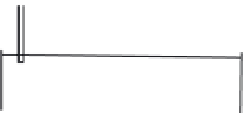Environmental Engineering Reference
In-Depth Information
0.70
Figure 4.3
Gains (positive) and
losses (negative) in streamflow
in cubic meters per second per
kilometer of channel length over
14 reaches of the Lemhi River,
east-central Idaho, August and
October 1997 (Donato,
1998
).
August 1997
October 1997
0.53
0.35
0.18
0
-0.18
1
2
3
4
5
6
7
8
9
10
11
12
13
14
Reach number
reservoir (Lee,
1977
; Belanger and Montgomery,
1992
; Murdoch and Kelly,
2003
; Rosenberry and
Menheer,
2006
). Correction factors from 1.05
to almost 2 have been proposed for converting
measured fluxes to actual fluxes (Rosenberry
et al
.,
2008
). Rosenberry
et al
. (
2008
) discussed
additional sources of error and provided guide-
lines for installing and monitoring seepage
meters in various stream and lake settings.
While seepage meters are used primarily
for quantifying surface-water and groundwa-
ter exchange, they also are employed in many
water-quality studies. Water samples collected
in chamber reservoirs can be removed and
analyzed for various chemical and biological
constituents. Belanger
et al
. (
1985
) made a total
of 270 seepage-meter measurements at 25 loca-
tions in East Lake Tohopekaliga, Florida, over a
9-month period to study the water and nutrient
budget of the lake. Seepage rates ranged from
less than 0.2 to more than 7 mm/d, with lowest
rates occurring near the center of the 4500-ha
lake. It was estimated that groundwater dis-
charge accounted for about 14% of flow into the
lake and 9% and 18% of the total phosphorous
and nitrogen loads, respectively, to the lake.
Water surface
Reservoir
Seepage cylinder
Water
Sediment
Figure 4.4
Full-section view of seepage meter showing
details of placement in the sediment.
however, to obtain representative averages over
any stream reach (upscaling of point measure-
ments is addressed in
Section 3.7
). Installation
of the meter at a measurement site requires
care; disturbance of bed sediments can alter
the natural exchange rate. The meter must be
inserted to a depth sufficient to prevent leaks
between the meter and the stream. Several
studies conducted under controlled laboratory
conditions have concluded that seepage meters
systematically underestimate actual exchange
rates because of resistance to flow within and
between the chamber and the measurement





























